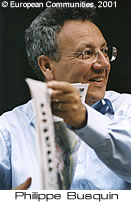EU scientists unravel genetic sequence of nitrogen-fixing bacteria
Scientists from Europe, Canada and America will today publish the complete genetic sequence of the nitrogen-fixing bacterium sinorhizobium meliloti. The breakthrough, achieved with the help of 2,442,000 euro of funding from the EU's Fourth Framework Programme Biotechnology Programme, allows a better understanding of the way in which bacteria fix atmospheric nitrogen and transfer it to plants. In the long term, it may help scientists to discover ways of enabling plants to carry out this nitrogen-fixing capacity for themselves, cutting out the need for nitrogen fertilisers. EU Research Commissioner Philippe Busquin said: 'This project demonstrates the contribution of modern biotechnology to sorting out some of our current environmental problems. By nature, these problems need to be tackled at a European level. EU-funded research provides the tools and the general framework to help European science innovate more easily and more rapidly.' Project co-coordinator Francis Galibert, from the University of Rennes, France, said: 'This work is important because of the nature of the bacterium which has been analysed and its role in our living world. Initiated in Europe, the project also shows how useful European funding is - in this case enabling several laboratories to form a network. I hope that Europe will maintain its support for sequencing small genomes of interest for biotechnology.' Nitrogen is an essential ingredient for plant growth, obtained from ammonium ions provided by nitrogen fertilisers or through the natural absorption of nitrogen in the atmosphere. Over 80 million tons of nitrogen fertiliser was manufactured last year, representing a market value of over 15 billion euros. Nitrogen fertiliser, however, only accounts for 30 per cent of the total nitrogen plant absorption of the chemical. The rest is taken in through natural processes such as symbiosis, which occurs between plants and a group of bacteria known as rhizobium. The bacteria transform atmospheric nitrogen into ammonium ions which can be easily absorbed by the plant. Any left over ions created in this way are released into the soil, helping to enrich and replenish it. A greater understanding of this form of natural symbiosis is therefore key to the development of sustainable, environmentally friendly agriculture. The sinorhizobium meliloti bacterium is a symbiotic micro-organism belonging to the rhizobium group, associated with many plant species important to soil and crop management, such as alfalfa (medicago sativa). It is also biologically similar to some plant and animal pathogens. The research found that S. meliloti contains a relatively large amount of genetic material, which is divided into three parts - the largest section, the chromosome, and two smaller parts, called megaplasmids. For 60 per cent of the genes identified, scientists have been able to propose biological functions, pending further testing, by comparing the gene sequences with those of other micro-organisms. The results suggest that the chromosome controls the key functions of the cell, while the role of making the bacterium membranes and fixing nitrogen are each dealt with by one of the two megaplasmids. Additional research is necessary to determine the function of the remaining 40 per cent of the genes identified in the bacterium The project involved scientific teams from Rennes and Tolosan in France, Gembloux and Louvain la Neuve in Belgium and Konstanz and Bielefeld in Germany, as well as teams from Ontario in Canada and Stanford in the USA.



